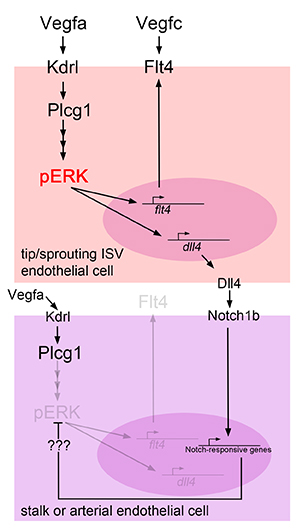Developmental angiogenesis
| Much of our work over the past fifteen years has focused on the mechanisms required for forming a new blood vessel, a process known as angiogenesis. By taking advantage of the zebrafish as a model system, we have made a number of novel insights into the cellular and molecular mechanisms that coordinate endothelial cell behavior during this process. Notably, our efforts have contributed to a model in which Vascular endothelial growth factors (Vegfs) induce angiogenic behaviors in endothelial cells to promote sprouting. At the same time, Vegfs induce the activation of the Notch signaling pathway, which drives a negative feedback loop in neighboring cells to reduce angiogenic behaviors. Together, these pathways allow coordination between "tip" and "stalk" cell outputs to enable blood vessel growth while maintaining a connection to the patent vascular network. |  |
Relevant Lawson Lab publications
Covassin, L., Villefranc, J., Kacergis, M., Weinstein, B. M., and Lawson, N. D. (2006) Distinct genetic interactions between multiple Vegf receptors are required for development of different blood vessel types in zebrafish. Proc. Natl. Acad. Sci. USA 103:6554-6559. PMC1458922.
Siekmann, A. F. and Lawson, N. D. (2007) Notch signalling limits angiogenic cell behaviour in developing zebrafish arteries. Nature 445:781-784.
Nicoli, S. Standley, C., Walker, P., Hurlstone, A., Fogarty, K. E., and Lawson, N. D. (2010) microRNA-mediated integration of haemodynamics and Vegf signaling during angiogenesis. Nature, 464:1196-200. PMC2914488.
Nicoli, S., Knyphausen, C. P., Zhu, L. J., Lakshmanan, A. and Lawson, N. D. (2012) miR-221 is required for endothelial tip cell behaviors during vascular development. Developmental Cell, 22:418-429. PMC3285411.
Shin, M., Quillien, A., Male, I., and Lawson, N. D. (2016) Vegfa signals through ERK to induce angiogenesis, but not arterial endothelial differentiation. Development, 143:3796-3805.